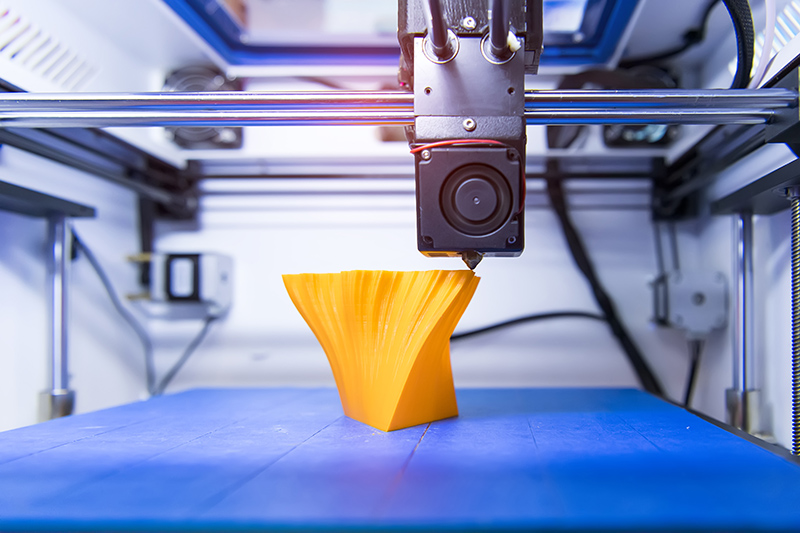If your creative skills sit in the 3D realm, then you may already be selling assets on one of the various marketplaces. With the rise of 3D printing becoming more prevalent, there are an increasing number of people purchasing their own 3D printers and selling their products on Amazon or Etsy. Good 3D printers are expensive! What if you either can’t afford a 3D printer or do not wish to buy one? There is still a way to tap into this growing market without investing in expensive hardware…
If you create a 3D model, you can sell a physical product using a 3D print-on-demand service such as Shapeways or Shop3D. Integrate these with marketplaces like Etsy to outsource the manufacture and shipping to customers. You are only responsible for the design and listing, avoiding the need to buy a 3D printer.
If you find this article useful then you might also be interested in 35+ Ways To Make Money as a Digital Creative.
Why Choose 3D Print-On-Demand?
Not all 3D printers are created equally. There are many different technologies at various price points. Low-quality 3D printers are not that expensive and are popular for home-use. However, if you want to sell a high-quality product then you will need a more expensive printer.
Using a 3D printing service to produce products for you, send you the stock and leave you to ship to customers yourself is one way of doing it. You are then responsible for the stock management, logistics and customer service which should not be underestimated as a time commitment.
If you use a 3D print-on-demand service that offers dropshipping (they deal with manufacture, packaging and shipment to your customers) then this hassle is removed, leaving you to concentrate on being creative and just managing the listings. This of course means you make less profit per item but in my opinion it is worth it. Time spent on creating new designs is more valuable than the increased margin you may get from doing the logistics and customer service yourself.
Types of Product Suitable for 3D Print-On-Demand
Metal products such as jewelry, are perfect to outsource to 3D print-on-demand services. The hardware that is capable of manufacturing these items will be out of the reach of most side-hustlers like you and me.
Some lower-quality plastic parts that might actually be viable to print on a home 3D printer will invite a lot more competition from those with their own equipment. Focusing on high-quality products or those that require advanced equipment makes using a 3d print-on-demand service a more valuable proposition.
Let’s take a look at some of the types of product that take advantage of a 3D printing service’s superior equipment.
Jewelry
Jewelry is typically produced by using 3D printing to create the wax mold and then casting a metal into this, usually also offered by the 3D printing service. These castings are then highly polished to create the intricate metalwork you would expect from a jewelry piece.
These types of product really do cater to those 3D artists that can design unique pieces and they can be sold for a high price as a result. Definitely one to consider if you have the skills.
Models and Figurines
Traditionally requiring very fine detail and commonly painted by the end customer, figurines or models have been popular products to produce with 3D printing for a while. They take advantage of the detail that the process can offer but avoid the historical disadvantage of them being printed in a single dull color.
New process advancements also mean that models can be printed in full high-definition color, creating a much more professional-looking product.
This category of product will require a great amount of skill in 3D modelling due to the level of detail required.
Replacement Parts
What’s more annoying than snapping a part on a product you own that makes it unusable? Finding out that you cannot get a replacement component and would have to replace the entire product, that’s what! We’ve all been there.
Thankfully with 3D printing you can design and sell a replacement part to other like-minded individuals. You might even design a component that functions better than the original and solves a common issue that customers might have.
Disclaimer: I am not a lawyer so you should seek specific legal advice before you decide to sell replacement parts for products.
To avoid getting in legal hot-water for intellectual property theft you should avoid copying the exact geometry of the part but make a part that can do the same job. You should also avoid making any safety-critical parts unless you fancy being sued in the event of an accident.
Identifying commonly-required parts or problems to solve will be the key to success here so you will need to do your research.
Whilst this product category is very tempting, personally, I would steer clear of making and selling replacement parts unless you have prior experience in this area and good liability insurance to cover you. As previously mentioned, consult a lawyer beforehand!
Niche Products and Inventions
As with our previous section, only proceed into selling functional products if you have covered yourself legally and know what you’re doing. If you have done so then this can be a perfect use of 3D printing technology.
If you’re an inventor then you no longer have to stump up a load of cash for manufacturing tooling and can cheaply produce and sell your product directly.
Go ahead and make that epic “Back-Scratcher 3000”!
There are so many possibilities and with the wide variety of materials and surface finishes now on the market you can realize your designs with no upfront investment. Go ahead and make that epic “Back-Scratcher 3000”!
3D Print-On-Demand Marketplace Integrations
So you’ve figured out how to 3D print your designs using a print-on-demand service but now you need somewhere to sell them. You may have a following on your own website that you can sell to or you might be wanting to list your product on a marketplace and access their millions of customers.
Either way, using a 3D print-on-demand service avoids the need for you to manufacture the parts, hold stock and manage logistics as they usually offer dropshipping.
To sell on a marketplace you will need to use the PoD service’s specific integration tool for that marketplace. This will connect your product listing to their service and mean that orders placed will be fulfilled by them.
Etsy offers integrations with a number of 3D-print-on-demand services which means you can market to their enormous customer-base but never need to handle any stock yourself.
Shapeways
Shapeways offers over 90 materials and finishes and ships to 160 countries.
Materials offered include:
- Sandstone
- Steel and Stainless Steel
- Aluminum
- Wax-Casted Metals (Brass, Bronze, Copper, Gold, Platinum, Silver, Gold or Rhodium-Plated)
- Plastic (PA12, Polypropylene, High Definition Full Color plastic, Fine Detail, Multi-Color Polyjet, TPU, Nylon)
Of particular interest personally, are the metals and full color printing which can open up some real possibilities.
Shapeways also offer a service through ZVerse to help customers translate their 3D models into files suitable for 3D printing.
Integrations they provide include Etsy, Shopify and their own API for direct integration into you website without the use of third-party platforms.
Shop3D
Shop3D is a 3D printing service offering a wide range of materials at over 200. These include:
- Metal casting (Gold, Silver Bronze, Brass and plated metals)
- Full-Color resin in photorealistic color
- Grey Resin
- Nylon
- Clear Resin
Shop 3D offer custom branding of their packaging so your brand will have much better visibility to your customers.
Integrations offered include Etsy, Shopify, WooCommerce and their own API for direct integration onto your site if you can code.
3D-Print-On-Demand Marketplaces
Most marketplaces for 3D printing either sell 3D models that customers can download and print themselves or they sell 3D printed products created by sellers on their own printers.
An alternative to this is to use one of the 3D printing services that also have their own marketplace. They allow creators to list their designs and the printing service will dropship the products to customers as with using an integration. This is simpler than integrating with Etsy and the customer base will be more specialized, although much smaller.
Shapeways
The Shapeways Marketplace is one of the only platforms hooked up to their own 3D printing dropshipping service so it really is a one-stop-shop.
The platform features a wide range of categories including Tech, Games, Minatures, Jewelry, Art, Home Goods and Accessories all available for order with a choice of materials and finishes.
Open a store on the Shapeways marketplace here.
File Preparation
File Type
You’ll need to output your model as an .stl file in most cases. For full-color resin prints you’ll also need to provide a .png or other file to hold the color information.
Model Preparation
Each piece of CAD software has it’s own steps and settings for exporting an .stl file so you’ll need to consult documentation specific to your own package for guidance. A good overview can be found on the Stratasys website here.
In addition to this, depending on the printing technology used you may need to include some additional geometry edits to make 3D printing possible. As an example, models made for printing by SLA will require escape holes to drain excess resin from the inside.
You will also need to consider the end application of the parts you have designed. This will include weight, strength and resolution to name a few factors.
To reduce weight and cost, models can be made hollow but the wall thickness should be set thick enough to provide the required strength. To add further strength to functional components, an internal support structure can be put in place that still keeps weight to a minimum.
The surface integrity needs to be checked to make sure there are no voids or errors that would make the model impossible to be printed. There are a number of tools available to check this. Shop3D recommend Autodesk Netfabb.
Conclusion
For 3D creatives, selling physical 3D-printed products are a good way to add extra value to designs that have been created. Being able to avoid the upfront investment of hardware and hassle of printing and shipping products will be welcome for many. Using a 3D-print-on-demand service makes this possible whether sold through Etsy, your own website or a specialist 3D printing marketplace.
If you’ve found this article useful then you might also be interested in 35+ Ways To Make Money as a Digital Creative.
Featured image: xiaoliangge / stock.adobe.com








